
A memorable journey on some of France’s famous trains, through stunning countryside, cities, hilltop villages, gorges and along the Med
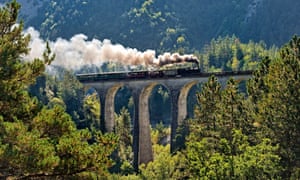
The high-speed train (TGV) from Paris-Montparnasse to Bordeaux is so fast that you could easily spend most of the two-hour trip queuing for a croque-monsieur in the buffet car. It also means that the Fontainebleau forest, the Loire’s chateaux, vineyards and medieval towns flash past in a very un-holiday-like blur. On a train tour of France, it’s best to take the more-relaxed TER trains and a few steam locomotives to enjoy the views.
This journey takes you through some of France’s most varied countryside, past hilltop villages, vineyards, pine and chestnut forests, into gorges and along the Mediterranean coastline, stopping at a few of the country’s less-touristy towns, each with their own particular regional dishes.

Start with the slow train from Paris-Austerlitz station to Amboise via Blois, where a year of events is underway commemorating the 500th anniversary of the death of Leonardo da Vinci at his Chateau du Clos Lucé . Explore the neighbouring Château d’Amboise (a tunnel runs between the two). Break the journey at the Château de Pintray (doubles €115 B&B) and enjoy a guineafowl supreme at La Pause du Temps restaurant (mains from €16).
It’s a three-hour train ride from Amboise to Angoulême, French capital of comic books, murals and Charente melons. Spend half a day at the riverside comic-art museum or wander round the old town. Stay at one of the antique-filled guesthouses in Le Plateau district: Jardins Secrets (doubles €80 B&B) or Les Jardins de la Cathédrale (doubles €70 B&B). Try the strawberries with violet cream and licorice marshmallow (€7) at Le St André bistro, or the escargots à la charentaise at the more formal Le Terminus (two-course lunch plus amuse-bouche, €15.50) beside the station.
Upside down, the TGV logo looks like a snail but the joke is coming to an end. As part of the network’s modernisation plans, the French rail operator, SNCF, is changing the name and logo of all its high-speed trains to InOui (premium) and Ouigo (low-cost).
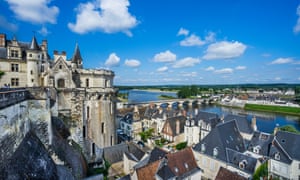
It takes just over 2½ hours to get to Montauban by InOui, speeding through the Nouvelle-Aquitaine countryside with a change at Bordeaux Saint-Jean. On the banks of the river Tarn, Montauban was the birthplace of artist Jean-Auguste-Dominique Ingres – a museum dedicated to him is reopening in the autumn. Try some of the regional specialities: duckling, cassoulet, slow-cooked lamb with lemon confit and olives at L’Estanquet (mains from €15), stop for a drink under the double-vaulted brick arcades of the Place Nationale and spend the night in one of the modernised cells of the Abbaye des Capucins , a former monastery which now has a pool and spa (doubles from €97).
Sète, on the southern coast, is a four-hour journey on one of the Intercités 100% Eco trains (this service is cheaper, only bookable online, there’s no onboard wifi or plug sockets but the slower trip gives more time to view stunning Carcassonne and Narbonne). The track runs along a narrow strip of land between the Thau lagoon and the sea at Sète. Stay at the three-star Le Grand Hotel (doubles from €120) and if there in summer book a room with a waterfront balcony to watch the joutes nautiques (water jousting). Try a dish of couteaux en persillade (razor clams in parsley, €15) or the filet de rascasse au pastis (scorpionfish in pastis, €25) at La Marine opposite the port (among scores of other fish restaurants). Visit the International Museum of Modest Arts and watch the elevating bridges where Sète’s canals meet the sea.
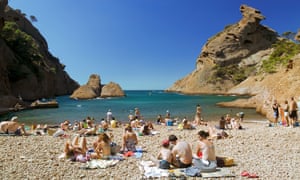
It takes three hours via Marseille to reach La Ciotat, scene of one of the Lumière brothers’ first films in 1895, Arrival of a Train at La Ciotat, where its first audience rushed out from the screening, believing the train was approaching. La Ciotat’s station has barely changed since and the town’s Eden cinema, restored for Marseille’s year as European culture capital in 2013, is the world’s oldest working picture house. Stay right on the beach at the Calanque de Figuerolles, (rooms and bungalows at the self-proclaimed “République Indépendante de Figuerolles” from €37). It also has a beachside restaurant, Chez Tania, serving bouillabaisse, grilled fish, vegan dishes and local Cassis wines (set menus from €41).
The railway hugs the coast eastwards until the Italian border, so sit on the sea side of the train and look out for the Delos/Palais hotel on the Île de Bendor off Bandol, the rust-coloured rocks of the Estérel and the horserace track in Cagnes-sur-Mer. Alight at Nice where the Hotel Aria (doubles from €77 room only) is only 200 metres from the train station with rooms overlooking a smart square. Eat next door in L’Antica , one of the best open-fire grills on the Riviera (mixed grill for two €54).

The next morning, find the Chemin de Fer de Provence station on rue Alfred Binet and take the Train des Pignes to Digne-les-Bains. The train is France’s last surviving one-metre-gauge line and chugs into the hills of Provence’s hinterlands. It’s a mesmerising three-and-a-half-hour journey over narrow viaducts, through gorges, lavender fields and pine forests. There are four trains a day and a steam locomotive replacement for part of the way on Fridays and Sundays in the summer.
Digne-les-Bains has two lavender festivals during the summer, thermal baths and is the gateway to Unesco’s first geopark. Stay at the 17th-century converted convent, Le Grand Paris, (doubles from €85 room only) or at the Hotel Villa Gaia (doubles from €84 room only), where they have spacious rooms, large grounds and organic home cooking. There are also artificial lakes nearby for swimming.
Digne is the end of the line so, instead of taking the narrow-gauge back to Nice, catch the bus to Aix-en-Provence (it’s a two-hour journey, bookable on the SNCF website) and then a fast train to Valence TGV before catching a local train to Tain-l’Hermitage, where a steam locomotive takes passengers into the gorges of the Ardèche. Casanova, Walter Scott and Boileau all mention Tain-l’Hermitage’s excellent wine, so have lunch and a glass of red at Le Vineum for €31 before a visit to the Cité du Chocolat (entry adult €9, child €7.50). Stay across the river at the Hotel de la Villeon, an 18th-century town house in Tournon (doubles from €95 room only).
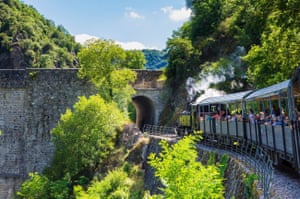
Paris-Gare de Lyon is just over two hours from Valence TGV on the fast train, and no train holiday in France is complete without a meal at the station’s Le Train Bleu . The sumptuous, belle époque dining rooms serve a lunchtime menu, including cheeseboard and two glasses of champagne, for €110 and a 45-minute traveller’s menu for €49.
The Guardian


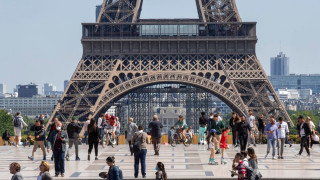





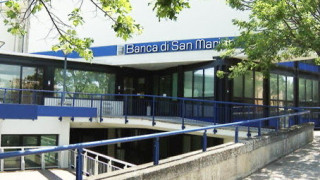


Leave a comment